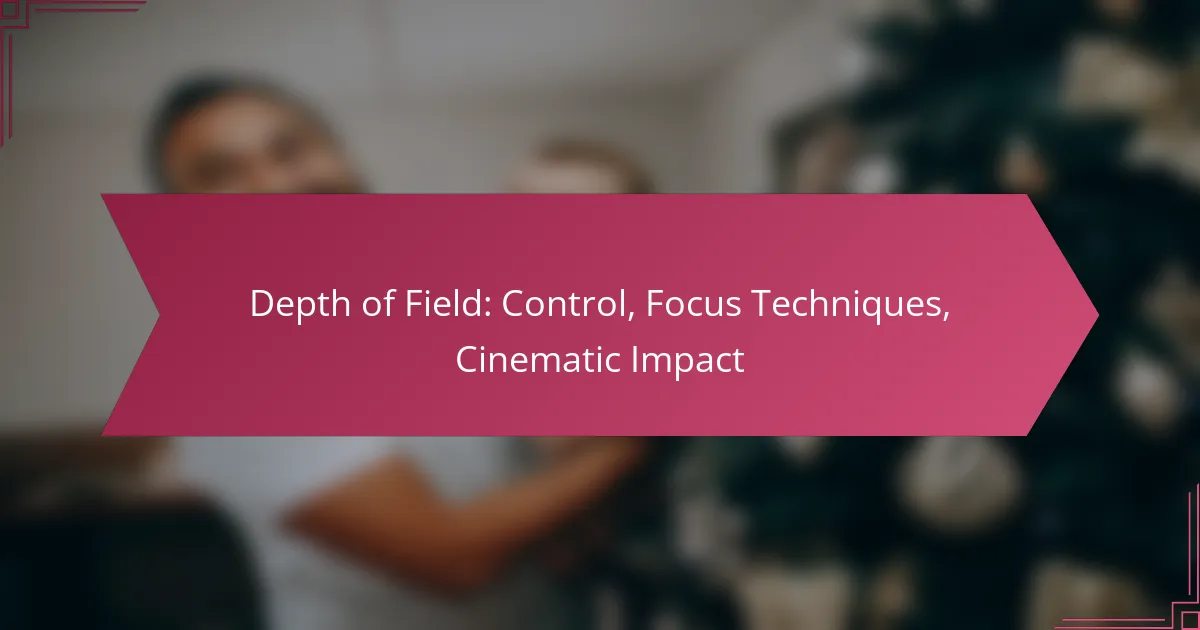Depth of field is a crucial aspect of photography and cinematography that involves manipulating focus to create specific visual effects. By adjusting factors such as aperture, focal length, and subject distance, photographers and filmmakers can control which elements of an image are sharp or blurred, thereby guiding viewer attention and enhancing emotional impact. Techniques like focus stacking and hyperfocal distance further refine this control, allowing for creative storytelling through visual emphasis.
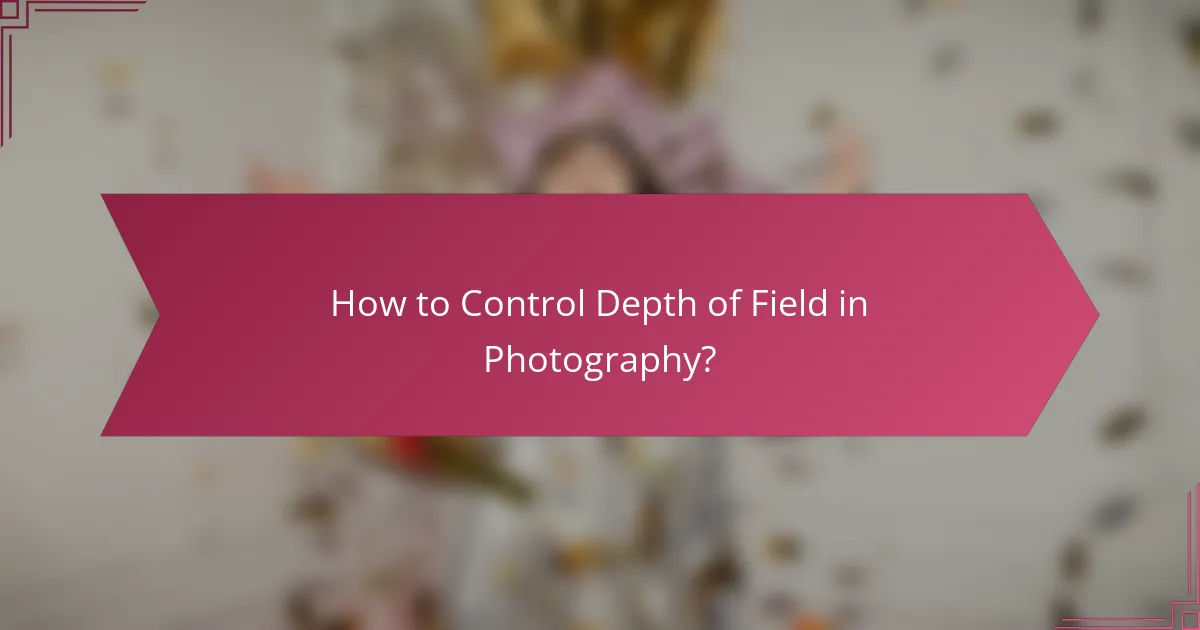
How to Control Depth of Field in Photography?
Controlling depth of field in photography involves manipulating various factors to achieve the desired focus effect. Key elements include aperture settings, focal length, subject distance, sensor size, and lens selection, each contributing to how much of the image appears sharp or blurred.
Aperture Settings
Aperture settings are crucial for controlling depth of field. A wider aperture (lower f-number) results in a shallower depth of field, blurring the background and foreground, while a narrower aperture (higher f-number) increases depth of field, keeping more of the scene in focus. For instance, an aperture of f/2.8 creates a pronounced background blur, ideal for portraits, whereas f/11 is better for landscapes.
When adjusting aperture, consider the lighting conditions. Wider apertures allow more light, which is beneficial in low-light situations, but can lead to overexposure in bright environments. Always balance aperture with shutter speed and ISO for optimal exposure.
Focal Length Adjustment
Focal length significantly impacts depth of field. Longer focal lengths (e.g., 85mm or 200mm) tend to produce a shallower depth of field, enhancing background blur, while shorter focal lengths (e.g., 24mm or 35mm) provide a deeper depth of field. This effect is particularly useful in portrait photography where isolating the subject is desired.
When selecting focal lengths, consider the composition and the distance from the subject. Using a longer lens from a greater distance can achieve similar depth of field effects as a shorter lens used up close.
Subject Distance
The distance between the camera and the subject plays a vital role in depth of field. The closer you are to the subject, the shallower the depth of field becomes. For example, when photographing a flower up close, the background will appear more blurred compared to a wider shot taken from further away.
To effectively manage depth of field, adjust your position relative to the subject. If you want more background detail, step back; if you prefer a blurred background, move closer. This simple adjustment can dramatically change the visual impact of your images.
Sensor Size Impact
Sensor size influences depth of field, with larger sensors generally providing a shallower depth of field compared to smaller sensors at equivalent settings. For instance, full-frame sensors create more pronounced background blur than crop sensors, even at the same aperture and focal length.
When choosing a camera, consider the sensor size in relation to your photographic goals. If achieving a shallow depth of field is important, a full-frame camera may be more suitable than an APS-C or micro four-thirds system.
Lens Selection
The choice of lens affects depth of field characteristics. Prime lenses often offer wider maximum apertures than zoom lenses, allowing for greater control over depth of field. For example, a 50mm f/1.8 prime lens can create a beautiful bokeh effect, while a standard zoom lens may only reach f/4.
When selecting a lens, think about your shooting style and the subjects you typically photograph. Investing in a quality prime lens can enhance your ability to manipulate depth of field creatively.
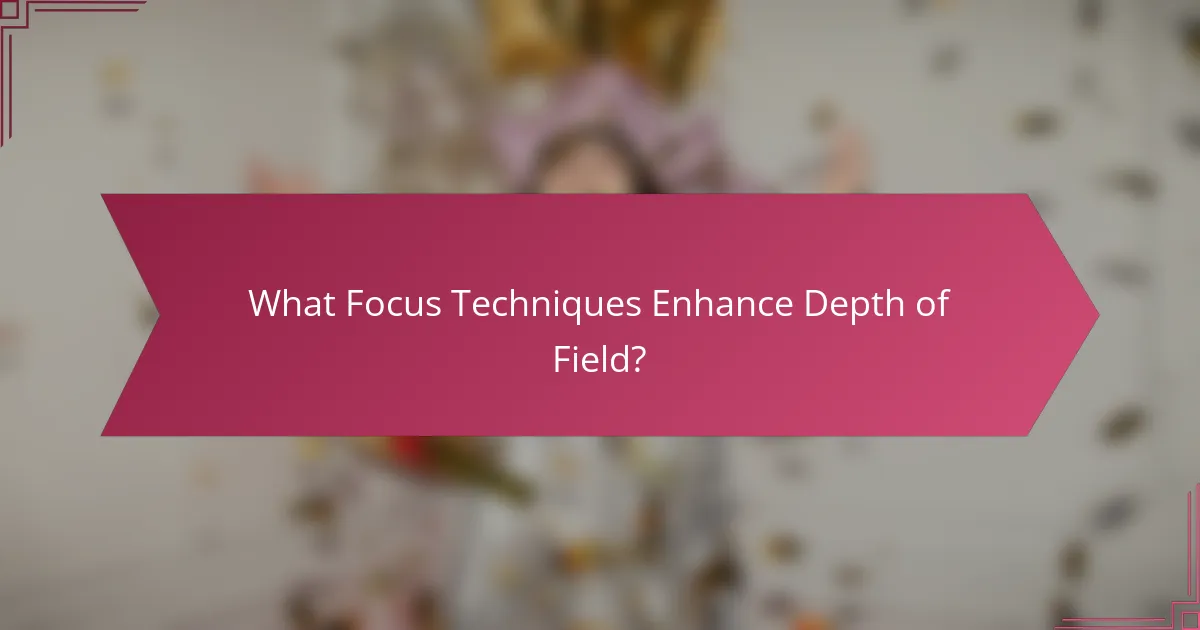
What Focus Techniques Enhance Depth of Field?
Focus techniques that enhance depth of field include methods like focus stacking, hyperfocal distance, and selective focus. Each technique offers unique advantages for achieving sharpness throughout an image or directing viewer attention effectively.
Focus Stacking
Focus stacking is a technique where multiple images are taken at different focus distances and then combined in post-processing. This method allows for an extended depth of field beyond what a single shot can achieve, making it ideal for macro photography or landscapes.
To effectively use focus stacking, ensure that your camera is on a stable tripod and that the focus points are evenly spaced. Software like Adobe Photoshop or specialized stacking programs can help merge the images seamlessly. Be cautious of moving subjects, as they can create artifacts in the final image.
Hyperfocal Distance
Hyperfocal distance is the closest distance at which a lens can be focused while keeping objects at infinity acceptably sharp. By focusing at this distance, you maximize the depth of field, which is particularly useful in landscape photography.
To calculate hyperfocal distance, you can use a simple formula or hyperfocal distance charts available online. Generally, using a smaller aperture (higher f-stop number) increases depth of field, but be mindful of diffraction effects that can reduce sharpness at very small apertures.
Selective Focus
Selective focus involves intentionally blurring parts of an image to draw attention to a specific subject. This technique is often used in portrait photography to isolate the subject from the background, creating a more compelling visual narrative.
To achieve selective focus, use a wide aperture (lower f-stop number) to create a shallow depth of field. This technique can enhance the emotional impact of your images but requires careful composition to ensure the subject remains the focal point. Avoid overly busy backgrounds that can distract from your main subject.
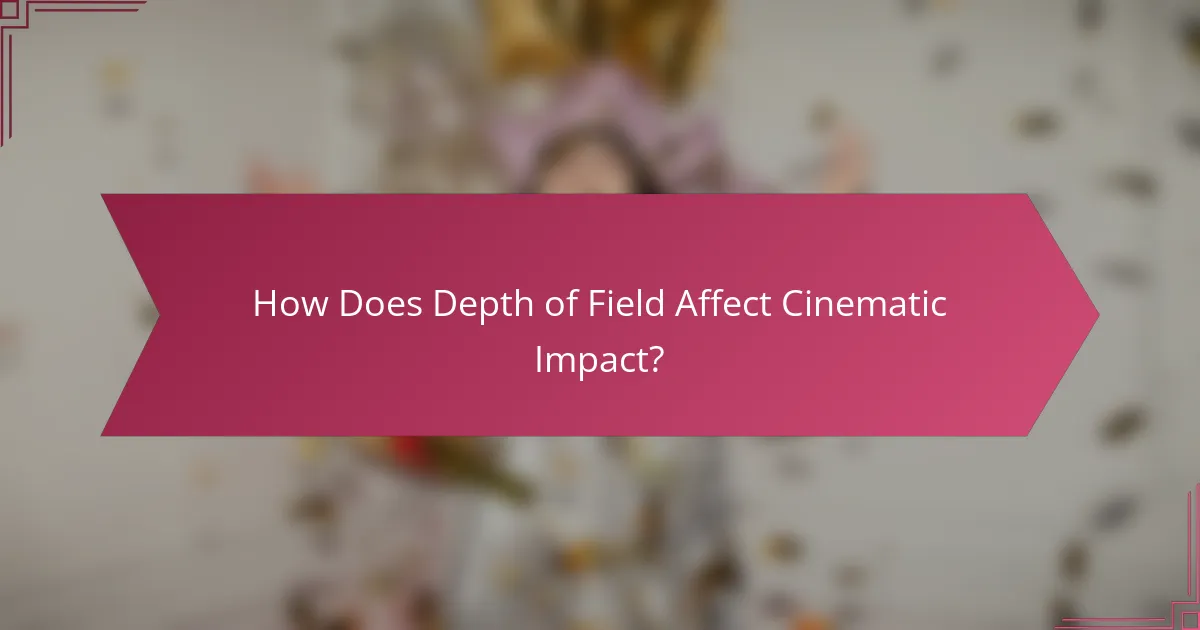
How Does Depth of Field Affect Cinematic Impact?
Depth of field (DoF) significantly influences cinematic impact by controlling which elements of a scene are in focus and which are blurred. This technique guides the viewer’s attention, enhances emotional resonance, and shapes the narrative experience.
Emotional Engagement
Depth of field can evoke specific emotions by isolating characters or objects, creating intimacy or tension. For instance, a shallow DoF can draw viewers closer to a character’s expression, intensifying the emotional connection. Conversely, a deep DoF might depict a broader scene, emphasizing isolation or chaos.
To effectively use DoF for emotional engagement, consider the context of the scene. Use shallow focus in intimate moments and deep focus in expansive, dramatic settings to enhance the viewer’s emotional response.
Visual Storytelling
Depth of field serves as a powerful tool for visual storytelling, helping to convey narrative elements without dialogue. By blurring backgrounds or foregrounds, filmmakers can highlight key actions or themes, guiding the audience’s focus where it matters most.
For example, in a suspenseful scene, a shallow DoF can obscure potential threats in the background, building tension. In contrast, a deep DoF can provide context, showing the environment’s role in the story. Always consider how DoF can support the narrative flow.
Genre-Specific Techniques
Different genres often employ distinct depth of field techniques to enhance storytelling. In romance films, shallow DoF is frequently used to create a dreamy, intimate atmosphere, focusing on the characters’ emotions. In horror, selective focus can heighten suspense by keeping threats partially obscured.
Action films may utilize a mix of shallow and deep DoF to maintain clarity during fast-paced sequences while emphasizing critical moments. Understanding these genre conventions can help filmmakers choose the appropriate DoF to match their storytelling goals.
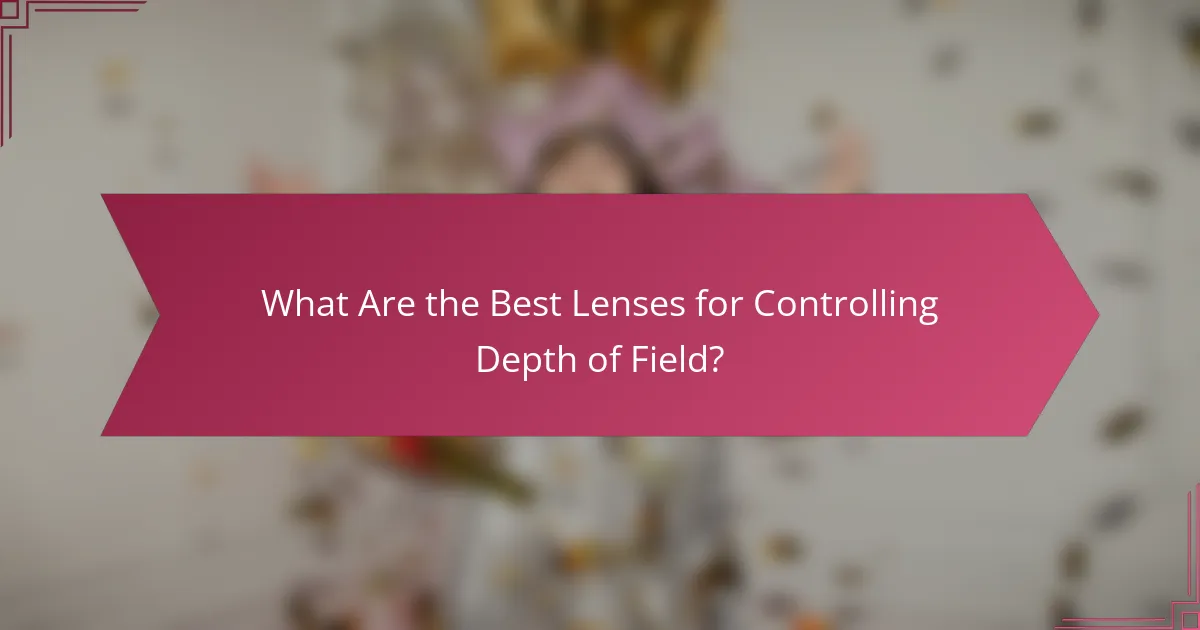
What Are the Best Lenses for Controlling Depth of Field?
The best lenses for controlling depth of field include prime, zoom, and macro lenses, each offering unique advantages. Understanding their characteristics helps in achieving the desired focus effects in photography and cinematography.
Prime Lenses
Prime lenses are fixed focal length lenses that typically provide a wider maximum aperture, allowing for a shallower depth of field. This feature makes them ideal for isolating subjects from the background, creating a pleasing bokeh effect.
Common focal lengths for prime lenses include 35mm, 50mm, and 85mm, each suited for different types of shots. For instance, an 85mm lens is often favored for portrait photography due to its ability to produce a soft background while keeping the subject sharp.
Zoom Lenses
Zoom lenses offer versatility with variable focal lengths, making them suitable for a range of shooting scenarios. While they may not achieve the same wide apertures as prime lenses, many modern zooms provide decent depth of field control.
When using zoom lenses, consider the aperture range; lenses with a constant aperture (like f/2.8) maintain depth of field consistency throughout the zoom range. This is particularly useful for video work where maintaining focus is critical.
Macro Lenses
Macro lenses are designed for extreme close-up photography, allowing you to capture fine details of small subjects. They typically have a longer focal length, which helps in achieving a shallow depth of field while keeping the subject in sharp focus.
When using macro lenses, be aware that depth of field becomes very narrow, especially at close distances. This necessitates careful focusing and composition to ensure the desired elements are sharp, making them excellent for product photography or nature shots.
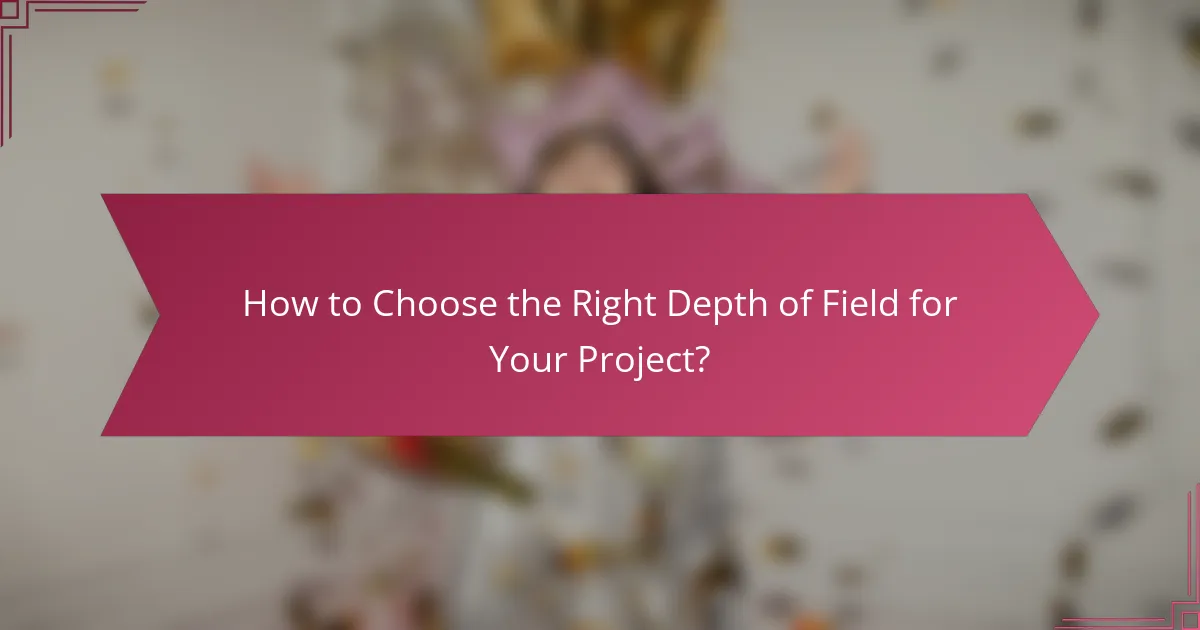
How to Choose the Right Depth of Field for Your Project?
Choosing the right depth of field (DoF) for your project involves understanding how it affects the visual storytelling and mood. A shallow DoF can isolate subjects and create a dreamy effect, while a deep DoF keeps more of the scene in focus, suitable for landscapes or detailed environments.
Project Type Considerations
Different types of projects require varying approaches to depth of field. For instance, narrative films often benefit from a shallow DoF to emphasize characters and emotions, while documentaries may use a deeper DoF to capture the context of a scene.
In commercial photography, a shallow DoF can help products stand out, while in architectural photography, a deep DoF is essential to showcase the entire structure clearly. Consider the story you want to tell and choose your DoF accordingly.
When planning your shots, think about the focal length and aperture settings that will achieve your desired DoF. A wider aperture (lower f-stop number) results in a shallower DoF, while a smaller aperture (higher f-stop number) increases the depth of field. Experimenting with these settings can help you find the right balance for your project.
